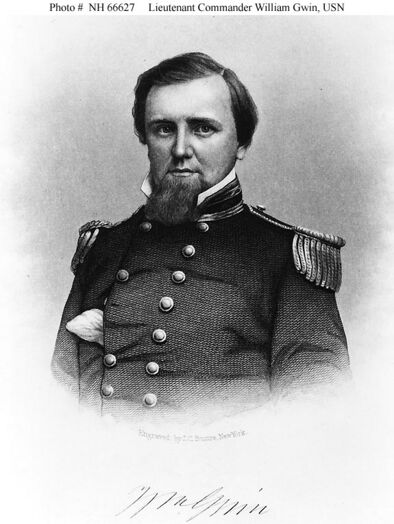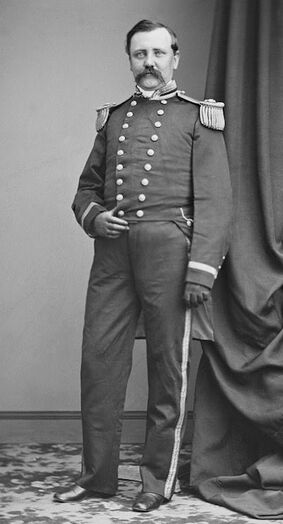WILLIAM GWIN, LCDR, USN
William Gwin '53
Photographs
Loss
William was lost on January 3, 1863 when he died of wounds sustained in action on December 27, 1862 during the Battle of Haines Bluff on the Yazoo River. He was the commanding officer of the gunboat Benton.
Other Information
From Wikipedia:
Born in Columbus, Indiana, Gwin was appointed a Midshipman on 7 April 1847. Gwin subsequently served in the frigate Brandywine on the Brazil Squadron until late in 1850. During the next five years he was assigned to the sloop of war Germantown, flagship of the African Squadron, the steamer Princeton and the brig Bainbridge. In September 1855, while serving in the latter, he was promoted to the rank of Lieutenant. From late 1857 until after the outbreak of the American Civil War in the spring of 1861, Gwin was an officer of the steamer Saranac and sloop of war Vandalia, both in the Pacific, and of the steam frigate Susquehanna in the Mediterranean.
Returning to the United States in mid-1861, Lieutenant Gwin began Civil War combat service in the newly acquired cruiser Cambridge and, later in the year, was assigned to the brig Perry.
He commanded several ships of the Mississippi Squadron and was one of Flag Officer Andrew Hull Foote's "can do" officers, displaying outstanding initiative, energy and dash. After the fall of Fort Henry he swept with his wooden gunboats up the Tennessee River all the way to regions of Alabama. This action was a major factor in the collapse of the Confederate lines far behind him in Kentucky. Fire support from two of his gunboats, Tyler and Lexington, helped save Union troops from disaster in the Battle of Shiloh, bringing high praise from General Ulysses S. Grant. He was wounded in action 27 December 1862, while commanding the gunboat Benton in the Battle of Haines Bluff on the Yazoo River.
He died from these injuries on 3 January 1863, on board a hospital ship in the Mississippi River. In reporting his death to the Navy Department, Gwin's squadron commander, Rear Admiral David Dixon Porter, remarked: "The country has lost one of its bravest officers."
From the Chicago Tribune, February 19, 1863 via researcher Kathy Franz:
A Tribute to Capt. Gwin.
[From the Indianapolis Journal.]
We find the following beautiful lines written on the death of Lieutenant Commander William Gwin, U. S. N., in the Cincinnati Commercial of Wednesday. Capt. Gwin was married to Miss Mary F. Hutchinson, of New York City, on the 11th of November last, and after a honey-moon of three weeks tore himself from his bride to take command of the gunboat Benton. With his gallant deeds at Shiloh, his fight with the ram Arkansas, and his action in the late ill-starred expedition up the Yazoo River, where he met his fatal wound, our readers are familiar. He died a true patriot and gallant sailor, and the tribute below, coming from Indiana's favorite poetess, is befitting one who thus gallantly gave his joyous hopes and gallant spirit for his country:A Wife's Wail.
O, say not he is dead! It is too soon –
As well the sun might set before his noon!
Say not that he is dead!His face is cold and pale; on his shut eyes
And palid lips a shadowy mystery lies:
But say not he is dead!Dead, in the strength and blossom of his prime?
No, no! O heaven, O God, it was not time –
Not time for him to die!Should it be thus, and could my heart beat on,
If he who is its hope, its life, were gone?
Soul of my soul, reply!No, no: he is too noble, true and brave;
I cannot give him to the cruel grave!
Tell me he is not dead!Speak to him, friends, speak to him, he may wake!
But do not, I beseech, for Christ's dear sake,
Tell me that he is dead!His pale lips move not; no, he cannot speak!
And still the shadow lies on brow and cheek –
O, would that I could weep!Dead dead; and the sun shines and the stars gleam,
And men speak calmly; surely I but dream!
Alas, I do not sleep!The world moves on; I hear its even tread;
It thinks, cares, toils and hopes, though he is dead
And gone beyond recall.Yet it will mention and applaud his name!
This is the price it pays, this breath of fame
For love, hope, life, all all!Dead in this hour of danger to the land
He periled life to save? O, death, thy hand
Has found “a shining mark!”Dead! I had garnered up my life in him!
Father, I cannot stay; my way is dim,
My stricken soul is dark! SARAH T. BOLTON, Indianapolis, January 1863.
From researcher Kathy Franz:
William's career included sailing on the Vandalia until 1859, then the Susquehanna in the Mediterranean.
In January 1862 he was commander of the gunboat Tyler. He participated in the battles of Forts Henry and Donelson, went up the Tennessee river to Muscle Shoals, and at the battle of Shiloh saved General Grant's army until General Buell arrived. Next, he went to Vicksburg with the Carondelet up the Yazoo to meet the rebel ram Arkansas. He commanded the Mound City at St. Charles until September 1862. Then he commanded the Benton.
William's father John was a merchant. His mother was Mary Ann (Mitchell). His siblings were Mary (Mrs. Jefferson Scott), Daniel, Ann (Mrs. Pascal Parks), Edward and Louisa.
He is listed on the killed in action panel in the front of Memorial Hall and is buried in New Jersey.
Career
From the Naval History and Heritage Command:
Midshipman, 7 April, 1847. Passed Midshipman, 19 June, 1853. Master, 15 September, 1855. Lieutenant, 16 September, 1855. Lieutenant Commander, 16 July, 1862. Killed in battle, 3 January, 1863.
Namesakes
Four ships in the United States Navy have been named in his honor:
- USS Gwin (Torpedo Boat No. 16) was commissioned in 1898 and decommissioned in 1914. She was renamed Cyane and reclassified YFB-4 in 1920, and finally sold in 1925
- USS Gwin (DD 71) was a Caldwell-class destroyer commissioned in 1920, and decommissioned in 1922.
- USS Gwin (DD 433) was a Gleaves-class destroyer, commissioned in 1941, served in World War II and sank in battle in July 1943.
- USS Gwin (DM 33) was a Robert H. Smith-class destroyer-minelayer, commissioned in 1944 and decommissioned in 1958. She was transferred to Turkey in 1971 and renamed TCG Muavenet (DM-357). She was scrapped in 1992.
The "Register of Commissioned and Warrant Officers of the United States Navy and Marine Corps" was published annually from 1815 through at least the 1970s; it provided rank, command or station, and occasionally billet until the beginning of World War II when command/station was no longer included. Scanned copies were reviewed and data entered from the mid-1840s through 1922, when more-frequent Navy Directories were available.
The Navy Directory was a publication that provided information on the command, billet, and rank of every active and retired naval officer. Single editions have been found online from January 1915 and March 1918, and then from three to six editions per year from 1923 through 1940; the final edition is from April 1941.
The entries in both series of documents are sometimes cryptic and confusing. They are often inconsistent, even within an edition, with the name of commands; this is especially true for aviation squadrons in the 1920s and early 1930s.
Alumni listed at the same command may or may not have had significant interactions; they could have shared a stateroom or workspace, stood many hours of watch together… or, especially at the larger commands, they might not have known each other at all. The information provides the opportunity to draw connections that are otherwise invisible, though, and gives a fuller view of the professional experiences of these alumni in Memorial Hall.
January 1848
January 1849
January 1850
January 1851
January 1852
January 1853
January 1854
January 1855
January 1856
January 1857
January 1858
September 1861
September 1862
January 1863

The "category" links below lead to lists of related Honorees; use them to explore further the service and sacrifice of alumni in Memorial Hall.

